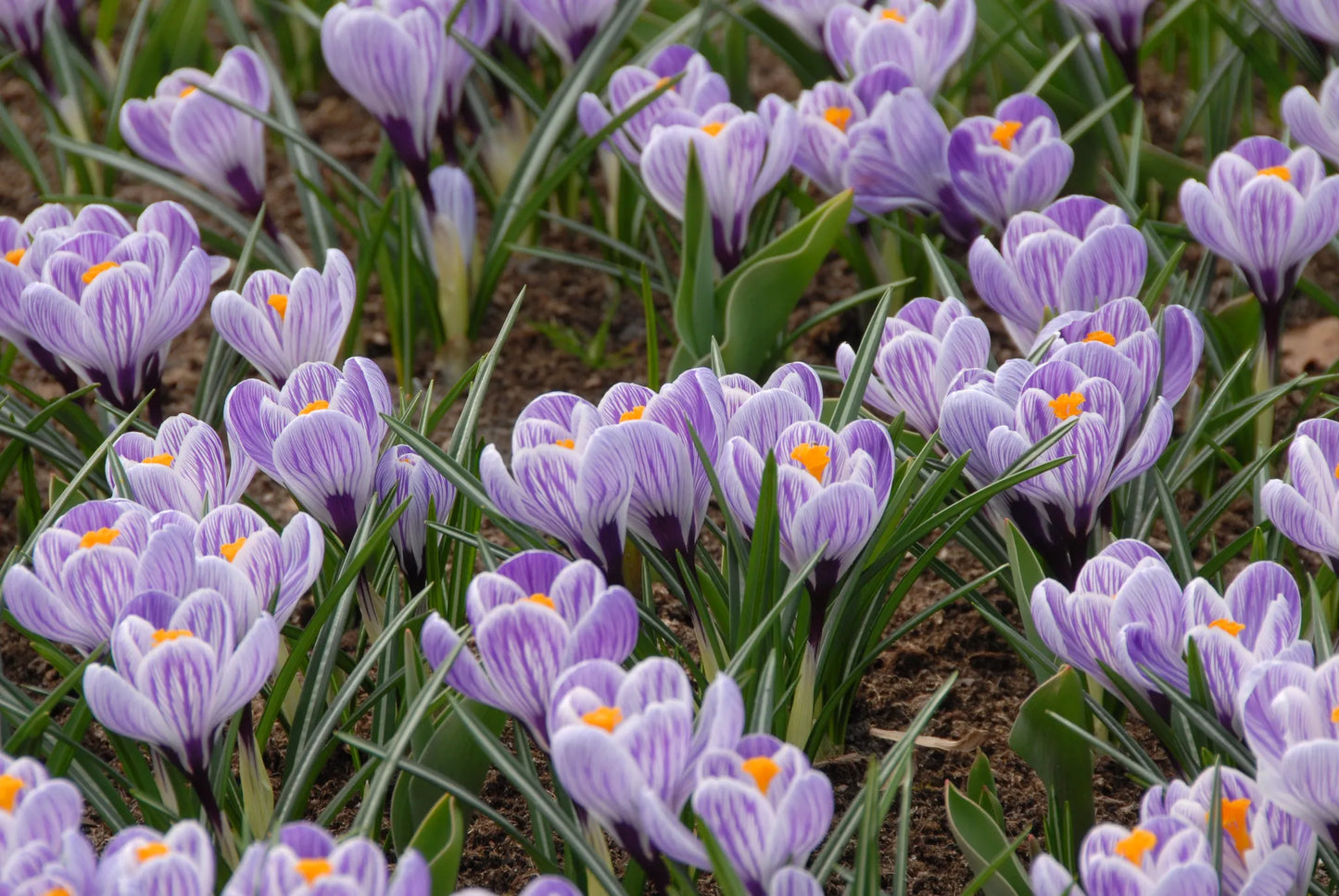-
Livraison dès 10 bulbes France, Suisse et Europe
Modalité livraison -
Grossiste Bulbes de fleurs en ligne
-
Bulbes de Qualité
-
Paiement sécurisé
Virement / chèques / Carte Bancaire /Chorus
Untreated Crocus Pickwick flower bulbs size 9/10 (2501900)
Untreated Crocus Pickwick flower bulbs size 9/10 (2501900)
PRICE per bulb € excluding VAT excluding transport
Delivery from mid-September to November - choice at the basket stage
Online shopping available in France and Belgium. For other countries, please request a quotation.
Couldn't load pickup availability
 Limited stock - Buy now and get it delivered when you're ready to plant
Limited stock - Buy now and get it delivered when you're ready to plant
- Delivery from 10 bulbs to France, Switzerland and Europe
Flower Color:
Usage:
Flowering:
View full details

Quality Crocus Bulbs for Florists and Individuals
Quick read / the essentials about our Crocus Bulbs
At Floriverse , we put all our expertise at the service of floriculturists as a specialist wholesale supplier of flower plants . The Crocus , an early and versatile perennial plant, proves to be a strategic asset for producers looking to diversify their offer. Whether for spring or autumn crops, our range allows you to buy calibrated, vigorous Crocus bulbs , suitable for demanding professional cultivation, with excellent naturalization capacity.
Our offer, segmented into conventional, untreated or organic bulbs, adapts to your specific specifications. With remarkable hardiness (down to -32 °C depending on the variety), great tolerance to dryness, and spectacular flowering even under snow, the Crocus is a relevant response to the current demand for local, sustainable and differentiating production. As a wholesale supplier specializing in flower plants , we select high-quality corms to ensure dense flowering, varied colors and optimal durability according to your market objectives.
Crocus is also energy-efficient, suitable for open-field cultivation without heating, making it a profitable plant in a context of energy sobriety. By choosing Floriverse, you benefit not only from technical advice and professional support, but also from the possibility of purchasing Crocus bulbs in large volumes, delivered quickly in France. Trust your specialist wholesale supplier of flower plants to integrate this strategic species into your cultivation plan.
Introducing our Crocus range
At Floriverse , we offer a wide range of Crocus flower bulbs, specially selected to meet the demanding needs of professional florists. We offer a comprehensive range of conventional bulbs, untreated bulbs, and a wide range of organic Crocus flower bulbs . This diversity allows growers to choose according to their specific business objectives and specifications, whether for traditional or certified organic production.
Market approach: Crocus cultivation in France
The Crocus Cut Flower Market in France: Analysis 2023-2025
Crocus cultivation for cut flowers represents a specialized segment of the French horticultural market, offering remarkable potential for professionals looking to diversify their offerings. Here's a technical overview to help you make strategic decisions when marketing crocus bulbs.
General context of the cut flower market in France
National production of cut flowers amounts to approximately 183 million stems per year, mainly concentrated in two regions: PACA (76.8 million) and Pays de la Loire (74.7 million). This market remains largely dependent on imports (85%), generating a significant trade deficit, estimated at 300 million euros for 2022. Despite this, the French floriculture sector is currently undergoing a profound renewal, notably thanks to the arrival of professionals from career changes, thus boosting practices and meeting a growing demand for local and sustainable products.
Crocus's Position in the Cut Flower Market
Crocuses are not among the five most widely produced cut flower species in France, traditionally dominated by peonies, anemone, gerberas, roses, and ranunculus. This low level of direct competition opens up interesting commercial opportunities. Crocuses offer several major advantages:
- Early flowering extending commercial possibilities from the end of winter.
- A great variety of varieties, including Crocus vernus, appreciated for its large flowers, and Crocus tommasinianus, suitable for shaded areas.
- A culture in the open ground, low energy consumption compared to species grown in heated greenhouses.
Consumer trends for 2023-2025
Following a period of crisis linked to the pandemic, the cut flower market is experiencing significant fluctuations. Despite a decline observed in 2022, positive signals have emerged since 2023, particularly for cut flowers sold individually. While the number of purchasing households remains slightly lower than before Covid (41.2% in 2022 compared to 43.7% in 2019), purchasing criteria are shifting significantly towards a marked preference for locally sourced and responsibly produced flowers.
Distinction between organic and conventional production
Although crocus-specific data are limited, the organic cut flower sector faces significant regulatory constraints, primarily related to phytosanitary approvals. The "Fleurs de France" label currently represents an important marketing lever, often preferred to organic labels. Crocus, which is relatively disease-resistant and requires few chemical inputs, represents an attractive opportunity for flower growers considering a transition to more sustainable or organic production.
Opportunities for Crocus Bulb Suppliers
For bulb suppliers targeting professional floriculturists, several major advantages are emerging:
- Differentiating positioning: In the absence of strong direct competition, the crocus allows producers to clearly stand out.
- Reduced energy costs: Thanks to its open-ground cultivation, it offers a substantial economic advantage compared to crops requiring intensive heating.
- Responding to new expectations: Growing demand for local and sustainable products represents a major market opportunity.
Strategic recommendations
To optimize your crocus bulb marketing strategy to professionals, here are our main recommendations:
- Segmented offering: Offer specific varieties according to organic and conventional segments.
- Precise technical support: Provide detailed technical itineraries adapted to the main French production regions.
- Demonstrate profitability: Promote the economic efficiency of crocus cultivation, particularly in terms of energy.
- Differentiating argument: Highlight the advantages of local, sustainable production that meets new consumer expectations.
Presentation of our commercial arguments
- Simple and seamless agricultural supply without complications
- Personalized technical advice
- Free quotes and advice
- Personalized quotes
- Complete technical itinerary
- Delivery possible within 15 days in season; advance reservation possible
- Careful delivery throughout France
- Crocus flower bulbs at producer prices
- Professional quality crocus flower bulbs
- Crocus flower bulbs delivered to your home
- Bulbs produced by specialist producers
- Decreasing prices according to the volume ordered
- Production from specialized nurseries
- Professional quality guaranteed
- Unbeatable value for money
- Responsive sales service with response and quote within 48 hours
- Recognized specialist in flower bulbs
- Floriculture Expert
- Dedicated technical support
- Crocus flower bulbs wholesale
- Crocus flower bulbs for sale online
Botanical characteristics of crocus
Taxonomy and main species
The genus Crocus belongs to the botanical family Iridaceae (Iridaceae) . Its full scientific name is written Crocus , followed by the species name, such as Crocus sativus for the saffron crocus or Crocus vernus for the spring crocus. The genus Crocus is large, comprising about 90 to 127 species and subspecies depending on the classification. They are small, herbaceous perennials , valued for their often early flowering .
Corm structure and influence of caliber
Contrary to popular belief, the crocus does not have a true bulb, but a corm (sometimes called a pseudo-bulb). This corm is an underground tuberous stem that serves as a storage organ for the plant. Crocus corms are generally between 8 and 10 cm in height , with an average diameter of around 4 cm. The circumference of the corms varies, for example between 8 and 9 cm for a size 8-9 , or greater than 11 cm for a size 11+ . The size has a direct influence on flowering , with larger sizes producing a better flower yield and being able to produce several flowers per corm , which is particularly interesting for Crocus sativus .
Plant dimensions and shape
The average height of mature crocuses is usually between 5 and 15 cm depending on the species and variety. Botanical varieties are often smaller, reaching 8 to 10 cm , while vernus crocuses can grow up to 15 cm. Some species such as Crocus speciosus can reach 15 to 20 cm . The general habit of the plant is upright, with flower stems rising vertically from the corm .
Foliage: morphology and growth cycle
Crocus foliage is basal and cauline, sheathing the base of the stem. The leaves are acaulescent , meaning they have no visible stem above ground. They are usually thin and linear , green in color with sometimes a whitish midline . The tunics covering the corm may be fibrous, membranous, or leathery. The foliage usually emerges before or at the same time as the flowers and should be left in place after flowering until it has completely yellowed , which lasts several weeks, to allow the corm to accumulate reserves .
Flowers: morphology, colors and flowering
Crocus flowers are characterized by a calyx or elongated cup shape, tubular at the base, opening to the sun. They have six tepals (three sepals and three identical petals). The flower tube varies in size from 3 to 7 cm in height . The dominant colors are white, yellow, mauve, purple, and blue, sometimes with orange hues or streaks . The fragrance of the flowers is generally discreet, or even absent in many varieties, although Crocus sativus has a slight scent. Each stem usually bears a single flower , but well-developed corms can produce several flower stalks. Flowering on a plant lasts on average 10 to 15 days .
Origin, cultural requirements and adaptation of crocus
Geographic origins and hardiness zones
The origin of crocuses is mainly in the Mediterranean regions , the Balkans and Asia Minor , but some species are present in Central Europe , Central Asia , the Middle East and North Africa . Crocus sativus is specifically native to the Mediterranean basin.
Optimal light exposure
For successful cultivation, crocuses absolutely require full sun . However, some autumn varieties or large-flowered hybrids can tolerate a semi-shaded location . The Crocus sativus species specifically requires a sunny exposure to optimize its production. The recommended sunshine is at least 6 hours of direct light per day for early varieties. South or southwest orientation is often preferred in France.
Soil structure and agronomic requirements
Soil is a critical factor . Crocus requires well-drained soil to prevent corm rot . It does not tolerate permanent moisture . The ideal substrate is a light, neutral to slightly alkaline soil (pH 6.5 to 8), with a clay-limestone or sandy-clay texture, rich in organic matter to promote floral development . Sandy or stony soils are very suitable. In heavy or clayey soil , careful preparation is necessary, including lightening with sand or peat . Good drainage implies a permeability of approximately 15 to 30 mm/h .
Watering, humidity and water management
The water requirements of crocus are moderate. In France, natural rainfall is often sufficient , especially in spring and autumn . Crocus sativus requires approximately 600 to 700 mm of annual rainfall , ideally distributed just before flowering . Watering is only necessary in the event of prolonged drought , taking care never to create stagnant moisture .
Fertilization adapted to flowering
In terms of fertilization, crocuses are not very demanding . In healthy, well-drained soil , additional fertilization is often not required . For intensive cultivation or in poor soil , a low-dose organic liquid fertilizer ( balanced NPK type) can be used during the vegetative recovery . Excess nitrogen should be avoided , as it promotes foliage at the expense of flowering . A contribution of mature compost is recommended before planting.
Life cycle, hardiness and multiplication of crocus
Dormancy and growth periods
Crocus is a perennial plant growing from its corm . Its life cycle is marked by a period of summer dormancy in warm, dry conditions. The colder temperatures of winter activate vegetative recovery . The growth and flowering cycle varies depending on the species ( spring or autumn ).
Hardiness according to species
Most crocus species are very hardy , tolerating winter temperatures down to -32°C (USDA zones 4 to 7). This covers almost all of metropolitan France . However, Crocus sativus is less hardy , preferring milder regions (USDA zones 6-10) and struggling to withstand temperatures below -12°C to -15°C without protection.
Propagation methods: seeds, corms, in vitro
Crocus is propagated primarily by two methods: sexually by seed and asexually by the production of daughter corms (bulbils) . Each mature corm can produce between 2 and 5 daughter corms per season, with a multiplication rate of 1:3 to 1:5 per year. These new corms reach flowering size in 2 to 3 years . Propagation by seed is slower, requiring 3 to 5 years to reach flowering. In vitro propagation is also used professionally for some varieties, allowing a faster multiplication rate (up to 1:20 per cycle). The corms multiply naturally in place , gradually forming larger clumps .
Crocus Cultivars, Planting and Care
Botanical and horticultural varieties
There are many crocus cultivars , divided mainly between spring and autumn flowering . Among the spring crocuses, we find Crocus chrysanthus (very early flowering, late winter, small yellow, white or blue flowers), and Crocus tommasinianus (very early, light mauve flowers, excellent naturalization). Also popular are Crocus vernus cultivars (spring flowering, later, mostly purple-violet or white, generally larger). For autumn crocuses, Crocus sativus (autumn flowering, intense purple flowers, grown for saffron) is the most notable. Crocus speciosus (Magnificent crocus, flowering between September and November, large intense blue flowers) is another interesting autumn species.
Planting schedule and depth
The planting calendar depends on the flowering period. Spring crocuses are planted from September to December (ideally September-October), while autumn crocuses are planted in July and August . The minimum soil temperature should be above 7-8°C .
The recommended planting depth generally varies from 5 to 10 cm . For large bulbs , a depth of 6 to 10 cm is recommended, and for Crocus sativus , the depth can be increased to 10-15 cm . The standard spacing is 6 to 10 cm between each corm, and specifically 10 cm for Crocus sativus . A density of 15 to 20 bulbs per m² is recommended for beds, but higher densities (50 to 100 bulbs/m²) are possible for a rapid groundcover effect.
Cultural maintenance in open ground
Crocus routine maintenance is relatively limited. Weeding is crucial, especially at the beginning of growth, to avoid competition. Weeding every 10 to 15 days may be necessary during the growth phase. Removing faded flowers is not necessary for ornamental crocuses. For Crocus sativus , flower harvesting (and therefore removal) is daily during flowering . The foliage should never be cut before it has completely yellowed , otherwise the corm will be weakened .
Lifting, dividing and mulching
Lifting and dividing corms is recommended every 3 to 5 years , generally in summer after the foliage has dried out . Daughter corms can be replanted . Mulching or seasonal protection is generally not strictly necessary in well-drained soil , given the hardiness of the crocus . The main risk is excess winter moisture which can lead to rot . In heavy soil, a mineral mulch (coarse sand, gravel) of 2 to 4 cm can improve drainage around the bulbs. Protection against the cold is only useful in the event of severe and prolonged frost on soggy ground . Rodents can be more of a problem than diseases.
To summarize: Our Crocus Bulbs
Crocus is a plant with strong horticultural potential for floriculturists wishing to promote early, economical and visually attractive flowering. At Floriverse , we support you in your varietal and technical choices as a specialist wholesale supplier of flower plants . Thanks to its adaptation to organic cultivation, its natural resistance to diseases and its ease of propagation, Crocus allows you to build a perennial and efficient crop.
You can buy Crocus Bulbs directly from our platform dedicated to professionals, with access to homogeneous, controlled batches, available in different sizes adapted to your objectives (flowering, naturalization, saffron). As a wholesale supplier specializing in flower plants , we offer seamless logistics, personalized quotes, and technical support to optimize your yields and anticipate the needs of your sales channels.
Crocus fully meets the market's new expectations: sustainable production, varied aesthetics, attractiveness for pollinators, and a very good work/yield ratio. To ensure the success of your next campaigns, consider purchasing crocus bulbs from a specialist wholesale supplier of flower plants recognized for their expertise and responsiveness. With Floriverse, you are choosing a reliable and committed partner for sustainable and profitable floriculture.
-
Untreated flower bulbs Crocus tommasinianus Ruby Giant size 5/+ (2501400)
Regular price €0,06 EURRegular priceUnit price / per -
Untreated Crocus Jeanne d'Arc flower bulbs size 7/8 (2501810)
Regular price €0,12 EURRegular priceUnit price / per -
Untreated flower bulbs Crocus chrysanthus Romance size 5/6 (2500700)
Regular price €0,08 EURRegular priceUnit price / per -
Untreated flower bulbs Crocus chrysanthus Dorothy size 5/+ (2503800) for individuals
Regular price €0,31 EURRegular priceUnit price / per -
Crocus Whale Shark® Untreated Flower Bulbs 7/8 Size (2505600)
Regular price €0,14 EURRegular priceUnit price / per
Floriverse: Online wholesaler of flower bulbs
-
-
Wholesale Flower Bulbs Online
We work with dozens of producers to offer you the best prices for your flower bulbs.
-
Quality
Our producers are selected for their reliability and the quality of their bulbs.
-
Your bulbs at the best prices
We work every year with your partner producers to offer you the best prices







